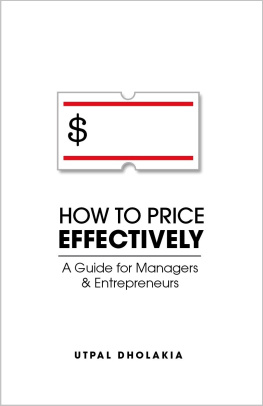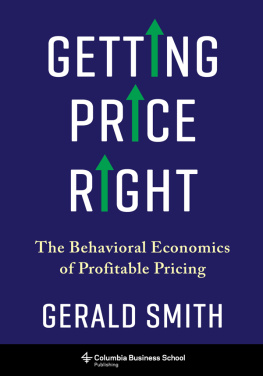HOW TO PRICE EFFECTIVELY
A Guide for Managers and Entrepreneurs
Utpal Dholakia
Copyright 2017 by Utpal Dholakia
First edition, v1.01
All rights reserved.
Book Layout 2017 BookDesignTemplates.com
Book cover design by Dequan Jin
ISBN 978-0-9991867-0-1
Contents
The greatest gift is the power to estimate correctly the value of things.
Le Rochefoucauld
[1]
The Purpose of This Book
Pricing is the moment of truthall of marketing comes to focus in the pricing decision. E. Raymond Corey
I have taught a graduate-level business school course on pricing strategy for well over a decade at Rice University. During this time, I have also worked with dozens of companies, from single-person startups to some of the largest corporations in the world on pricing issues. I have helped make pricing decisions for everything, from industrial machinery costing millions of dollars to a line of craft beer, from a medical test to detect sexually transmitted diseases to an upscale nightclub. Throughout, it has surprised me just how much otherwise smart, knowledgeable, and confident managers and entrepreneurs are intimidated when it comes to making pricing decisions, and how often they avoid thinking deeply about pricing issues.
The Significance of Pricing Decisions
Pricing decisions are among the most important and impactful business decisions that a manager can make. They are arguably one of the few decisions that affect a companys revenues directly. Paradoxically, setting a price or changing one is also among the easiest things to do today. One push of a computer key, one revised number in a spreadsheet, or a new price label affixed to a product, and the pricing is done.
When made thoughtfully, using a structured process that takes the relevant factors into account, and when executed competently at the companys frontlines, pricing decisions can propel the company on a path of sustained differentiation, rapid growth, healthy profits, satisfied customers, and engaged employees. However, if pricing is done haphazardly, using old traditions without sound reasoning, or with cookie-cutter methods that only pay attention to the companys costs or the prices of one particular competitor, it can lead to lost opportunity. Defective pricing can fritter away a companys competitive advantage, leaving customers irate, employees confused, and sales in a freefall. Simply put, pricing decisions are make or break decisions.
What is more, pricing decisions are recurrent. Through both lean and prosperous periods, whether introducing an exciting new product or only trying to sell the same old products, whether it is in the drivers seat or struggling to catch up with its competitors, every company must periodically set prices for new products and change prices for existing products. Each new day brings the opportunity to erase past pricing mistakes and to turn the page over. On the flip side, past pricing performance is not indicative of future success. Every new pricing decision is fraught with risk. This is why using a structured and consistent process is invaluable.
Pricing decisions are almost never discipline-specific, nor are they made and executed in a silo. The marketing, sales, strategy, operations, and accounting functions each play a significant role in the success of a companys pricing strategy. Pricing choices are grounded in the companys culture, and influenced by its historical thinking. For many managers, the philosophy of: Lets not rock the boat, this is how we priced our products last year, and everything seemed fine. So lets do it the same way again this year seems like a sensible way to make pricing decisions.
In fact, the most common problem I encounter when working with established companies is how to pull them away from tradition-bound pricing methods to which they have become accustomed. In most cases, this means focusing almost entirely on covering costs. The company ignores other relevant factors such as its overall marketing strategy and the value proposition it wants to deliver to customers, the economic value customers place on its products, and the reference prices they use for comparison, including the prices of major competitors.
The challenge is different but equally significant for startups. Most startup founders give little thought to pricing questions, and tend to be unduly swayed by industry norms. They imitate the pricing approach of peer companies, or of exciting startups that have gone on to become wildly successful, without carefully thinking about whether such pricing models make sense for their new business.
What is a good pricing decision? What factors should you consider and what methods should you use when making pricing decisions? Is charging revenue-maximizing prices (assuming you can figure out how to do this) the best thing to do? Alternatively, is the price that maximizes the companys profit the best one? Can you do both, maximize revenue and profit simultaneously? Which factors should you consider when setting and changing prices? How can you earn the prices you have set? How will you know that you have made the right pricing decision and that your pricing strategy is working? What performance measures should you track to evaluate your pricing? What are the pricing best practices in business and consumer markets? These questions animate this book. They form the foundation to build an effective pricing strategy for your organization.
The Value Pricing Framework
To answer these questions, this book will provide an in-depth discussion and understanding of the value pricing framework that I have developed over the past decade. The value pricing framework is a structured, versatile, and comprehensive method for making good pricing decisions and executing them. It weaves together the latest thinking from academic research journals, proven best practices from the leading pricing experts, and ideas from other fields such as medical decision making, consumer behavior, and organizational psychology. It is strategic, structured, multi-faceted, and its use will instill confidence in your companys products, and satisfaction with the price and the pricing process in your employees and customers. The value pricing framework has been extensively road-tested. Over the past decade, it has been employed in many different contexts to tackle a variety of pricing issues successfully. It is applicable whether you work for an established company or if you are about to launch a brand new startup.
Even when managers or entrepreneurs do not know of it, or call it as such, many of them employ parts of this framework in a piecemeal way. In this book, my goal is to formalize this structured method, by describing, explaining, and applying each part of it in depth. After reading this book, you should have a clear understanding of what a good pricing decision is, which factors you should consider when making one, the role played by each factor, how they work together, the importance of price execution, and how to evaluate the success of pricing decisions. You will also be introduced to a set of useful and straightforward tools to implement the value pricing framework , and study many examples and company case studies that illustrate its nuances. The purpose of this book is to provide you with a comprehensive, practical guide to making, executing, and evaluating pricing decisions.
Whether you are a manager of marketing, sales, operations, accounting, or strategy functions, a consultant, or an entrepreneur, if you play a role in your companys or your clients pricing activities, you will find the material covered in this book to be useful. When you have finished reading it, I hope the building blocks of the value pricing framework and the philosophy behind it will be part of your everyday vocabulary and mindset. Each time you encounter an opportunity to evaluate, change, or realize your companys prices, you should be able to rely on this framework to make good pricing decisions.









